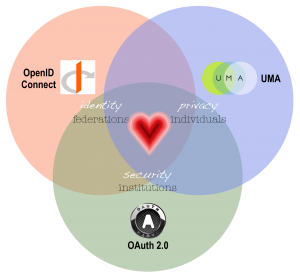 What is HEART WG?
What is HEART WG?
The HEART Working Group intends to harmonize and develop a set of privacy and security specifications that enable an individual to control the authorization of access to RESTful health-related data sharing APIs, and to facilitate the development of interoperable implementations of these specifications by others
List of Specifications
Below are proposed specifications that we intend to link to HTML as the specifications are released:
- HEART profile for OAuth 2.0.
- HEART profile for OpenID Connect.
- HEART profile for Fast Healthcare Interoperability Resources (FHIR) OAuth 2.0 scopes.
- HEART profile for User-Managed Access (UMA).
- HEART profile for FHIR UMA resource set types, scopes, and claims-gathering flows (referencing the previous specifications as appropriate).
Participation
The easiest way to monitor progress on the HEART Specification is to join the mailing list at http://lists.openid.net/mailman/listinfo/openid-specs-heart.
Please note that while anyone can join the mailing list as a read-only recipient and listen to the calls, posting to the mailing list or actively contributing (all spoken comments are considered contributions) to the specification itself requires the submission of an IPR Agreement. More information is available at http://openid.net/intellectual-property. Make sure to specify the working group as “OpenID HEART”.
Links to the wiki and other relevant sources can be found on our Resource page
The working group specification repository is kept at https://bitbucket.org/openid/heart . In this repository, only approved sub-versions are committed.
Meeting Venue and Schedule 
NOTE:SPECIAL DATE and TIME – F2F :TBD Stay Tuned!
- Weekly Monday Meetings
- When: 1 PM PST/4 PM EST
- Where: Gotomeeting – https://global.gotomeeting.com/join/785234357
- When: 1 PM PST/4 PM EST
- GoToMeeting software is available on Mac, PC, iPhone, and Android Phone.
- Using VoIP option of GoToMeeting is preferred. If you have to absolutely use plain old telephone some reason, here is the US phone number: +1 (619) 550-0003. Access Code 785-234-357
- Please Note: Number of the participation to the call is limited to 20 most active members at the discretion of the chair due to the number of lines available.
Version Control
- SourceTree (GUI application for Mac OS X and Windows, http://www.
sourcetreeapp.com/) - Git CLI (cross-platform command line client, http://git-scm.com/
downloads)
- Tell Debbie/Eve the userid – they will get you write privileges.
- git clone git@bitbucket.org:myuserid/
heart.git
- git remote add upstream git@bitbucket.org:openid/
heart.git
- git checkout master
- git pull upstream master
- git checkout -b newbranch master
- git add changedfile.xml
- git commit -m ‘Reworded introduction in changedfile.xml’
- git push origin newbranch
Link to the Issues
- TBD
